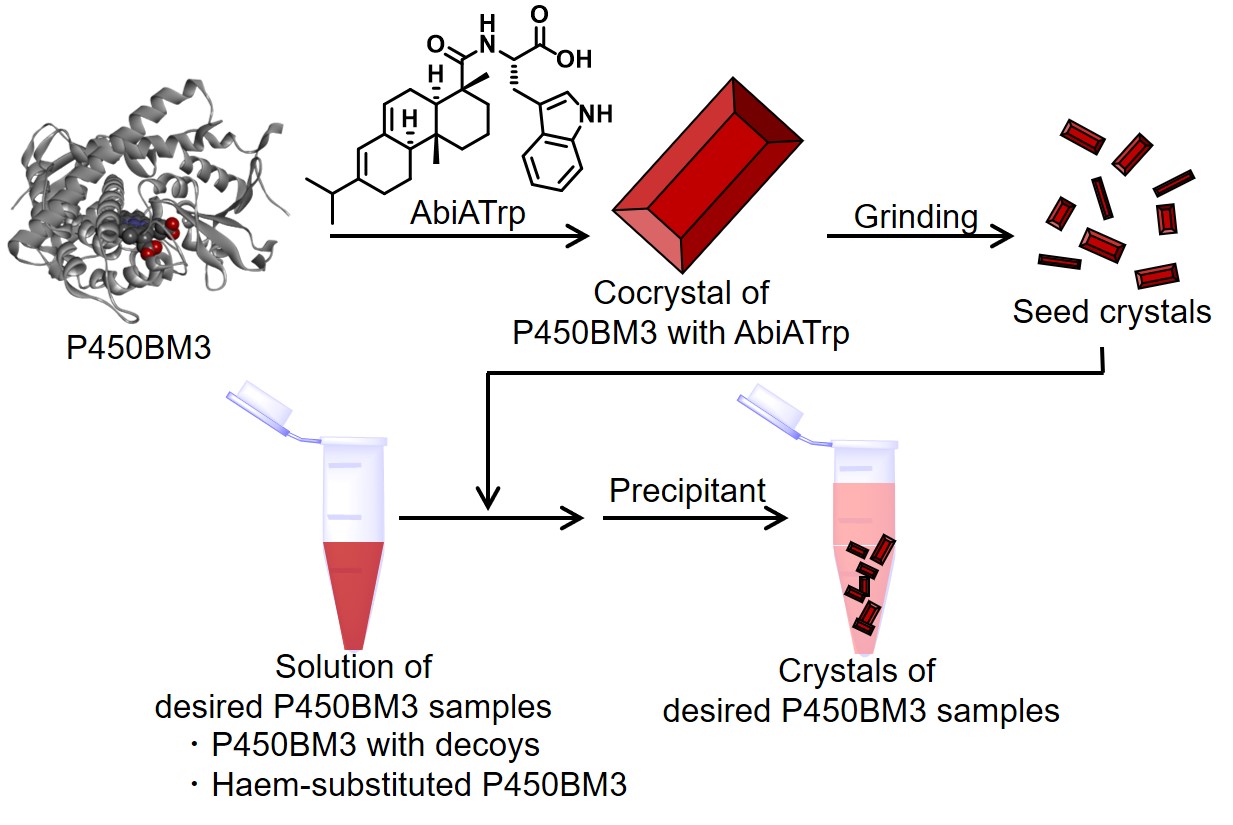Research Introduction
Development of Biocatalysts Based on Cytochrome P450s
Chapter 2 Functional modulation of P450BM3 using decoy molecule and its application to biocatalyst
Episode 8: Rapid crystallization of P450BM3 by crystallization-inducing decoy molecule
Due to the successful development of the 3rd generation decoy molecule, restrictions on decoy molecule design have been extensively removed. After that, many decoy molecules have been created based on the structures of peptides, drug molecules and natural products. The decoy molecule has been developed for improvement of conversion efficiency and stereoselectivity in the conversion of unnatural substrates by P450BM3. Recently, we succeeded in discovering a decoy molecule with a unique function. In the process of searching for decoy molecules based on natural products, AbiATrp in which abietic acid (organic acid contained in pine resin) and tryptophan were linked was synthesized and added to P450BM3 to hydroxylate non-natural substrates. Unfortunately, its reaction efficiency was disappointing, meaning that AbiATrp were regarded as a failure. However, when the crystal structure of P450BM3 with AbiATrp was performed, it was possible to determin the crystal structure with much higher resolution (1.22Å) than the co-crystals with the conventional decoy molecules. Moreover, the formation of co-crystals of P450BM3 with AbiATrp was rapid, indicating that AbiATrp is a unique decoy molecule that can accelerate the crystallization of P450BM3. More interestingly, we also discovered that co-crystals of P450BM3 with various decoy molecules other than AbiATrp can be rapidly obtained by crushing a P450BM3-AbiATrp crystal and using it as a seed crystal. The crystallization speed is extremely rapid. For instance, formation of fine crystals can be confirmed within a few minutes after the seed crystal is added. This cross-microseeding method enables the crystal structural analyses of not only P450BM3 with various third-generation decoy molecules, but also for heme-substituted P450BM3 containing various metal ions. This method not only provided a guideline for the rational design of decoy molecules, but also was a great achievement that led to the investigation of the reaction mechanism of P450 based on crystal structure analysis.

Please refer to this paper for details.
- J. K. Stanfield, K. Omura, A. Matsumoto, C. Kasai, H. Sugimoto, Y. Shiro, Y. Watanabe, O. Shoji "Crystals in Minutes: Instant On-Site Microcrystallisation of Various Flavours of the CYP102A1 (P450BM3) Haem Domain" , Angew. Chem. Int. Ed., 59, 7611-7618 (2020), Angew. Chem., 132, 7681-7689 (2020)
https://doi.org/10.1002/anie.201913407
https://doi.org/10.1002/ange.201913407

Chapter 2 Episode 9: Systematic evolution of decoy molecules through multi-step screening


